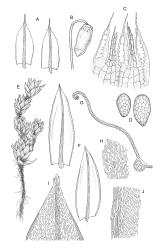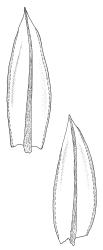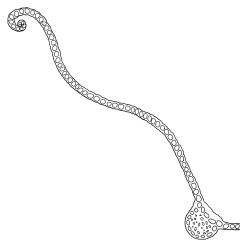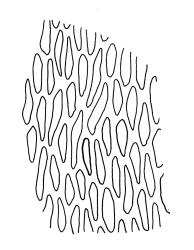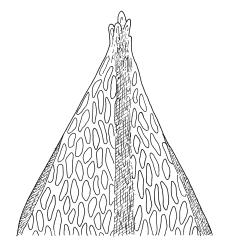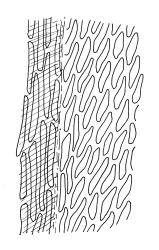- ≡ Gemmabryum crassum (Hook.f. & Wilson) J.R.Spence & H.P.Ramsay, Phytologia 87: 66 (2005)
- ≡ Imbribryum crassum (Hook.f. & Wilson) J.R.Spence & H.P.Ramsay, Telopea 15: 146 (2013)
Plants yellow-brown above, often red-brown below, not or scarcely lustrous, serially comose, forming rather compact turves. Stems red-brown, to c. 17 mm, usually branching by innovation but often with single branches arising from within a comal (perichaetial) whorl, densely beset with brown, coarsely papillose rhizoids, in cross-section with 2–4 layers of very thick-walled cortical cells and a distinct central strand. Leaves strongly comose, usually serially, erect-spreading when moist, tightly appressed but otherwise little altered when dry, oblong-ovate, gradually tapered to an acute, ± cuspidate apex, those of comae 2.0–2.5 × 0.6–0.75 mm and with lamina ± equal the total leaf length, concave, not plicate, lacking red secondary pigments, bluntly serrate or occasionally nearly entire (as illustrated here) near apex and entire below, very weakly bordered and strongly revolute at margins, not decurrent; upper laminal cells oblong-rhombic, thick-walled, not porose, c. 21–30 × 7–8 µm and mostly 3–4:1, not altered at apex, becoming longer (to c. 54 µm) in lower half of leaf, those adjacent to the costa (at mid leaf) oriented obliquely; marginal cells ± elongate in c. 5 rows at mid leaf to form a very weak border (obscured by revolute margins); basal cells shortly rounded-oblong in several rows, the lowermost ± brown (never red). Costa concolourous with lamina, mostly short-excurrent in a small cusp. Brood bodies (including tubers) absent.
Dioicous. Perichaetia usually hidden by 2–4 innovative branches; perichaetial leaves ± larger than vegetative leaves but not otherwise differentiated. Perigonia terminal, the inner bracts much smaller than surrounding comal leaves, enclosing numerous antheridia. Setae c. 15–25 mm, red-brown, cygneous just below capsule; capsules horizontal or pendent, oblong-cylindric, 2.0–2.7 × c. 0.8 mm, with an ill-defined neck c. ⅓ the total length and scarcely altered when dry; operculum conic and bluntly apiculate. Exostome teeth pale throughout, finely striolate below, weakly baculate near apices; endostome with perforate (not fenestrate) segments equal the teeth, and well-developed appendiculate cilia in groups of 3. Spores 8–10 µm, smooth.
Wilson 1854, pl. 86, fig. 1; Ochi 1970, fig. 23.
Bryum crassum differs from B. appressifolium (which also has strongly revolute leaf margins) by having a strongly comose habit, much less strongly excurrent costae, and the peculiar oblique orientation of the juxtacostal laminal cells. Rosulabryum subtomentosum and R. billardierei both differ from B. crassum in having porose, non-obliquely oriented laminal cells, stronger leaf borders of elongate cells, and more spreading leaves with recurved apices.
Confusion is also possible between B. crassum and B. campylothecium but the latter species (q.v.) differs by a number of features, including excurrent costae that form stout, elongate awns.
NI: N Auckland (Manukau Harbour) including offshore islands (RT), S Auckland, Gisborne (Te Tiki), Hawke's Bay (Wairoa), Wellington (Mt Ruapehu); SI: Nelson (Cobb Valley), Otago (Wānaka).
Australasian. Tasmania*. Reported from mainland (south-eastern) Australia by Scott & Stone (1976) and others.
This species is common and widespread on the central volcanic plateau (S Auckland L.D.) but is less well known elsewhere. On soil, mostly in dry, open situations in tussock grassland or manuka (Leptospermum scoparium) and/or Dracophyllum scrub. Commonly associated species include B. caespiticium, Campylopus introflexus, Ceratodon purpureus, Chrysoblastella chilensis, and the lichen Cladia aggregata.
The serially comose habit together with strongly but narrowly recurved leaf margins, and short-excurrent costae give B. crassum a distinctive aspect. Microscopically, the very incrassate and non-porose laminal cells, together with the obliquely oriented juxtacostal cells provide distinction from all other N.Z. species. The leaf dimensions given are for well-developed leaves in the comae. Generally, the leaves of the lower stem are much smaller (often <1 mm) and increase in size abruptly in the comal whorls, with only the best-developed leaves >2 mm in length. The peristome teeth typically have c. 25–30 trabeculae. This feature was given some emphasis by Scott & Stone (1976, p. 284), but appears to have little diagnostic value.




